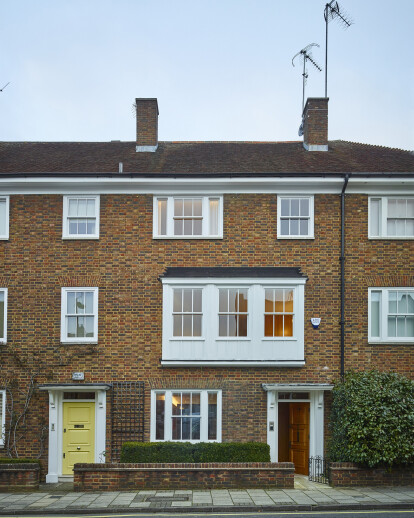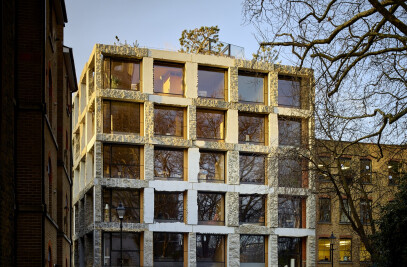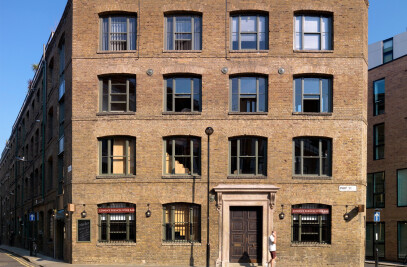If there is a guide to working with existing structures it could perhaps be titled‘Explore, Restore Ignore’. Explore the physical condition, fabric methodology and the social context that brought the specific design about. What changes have occurred since and why? Restore and Ignore with judicious reflection those areas that benefitthe new narrative
Surrounded on three sides by eight and nine storey mansion blocks shielding it from the heavy traffic onBayswater Road and tourism on Queensway,Caroline Place is a quiet enclave of late 1950’s terraces north of Hyde Park and Kensington Gardens.Built with a Modern Northern Europeansensibility of sharp brick lines and crisp mortar joints layered with softer timber detailing, their interiorlayouts remained firmly rooted in an earlier English Edwardian tradition. Retaining adesirous separation of served and servant areasofmaids’ rooms, sculleries, coal houses with a working rear yard. Servnatsoccupying the ground level with owners set out above,across larger light filled rooms.In the immediate post war period Bayswater had however already begun to lose its luster to that class,so much so that within a decade of being builtits new younger inhabitants found these social conventionsto be out of step with their aspirations.Undertaking iconoclastic remodelingand clearing out of the interior sub-dividing walls and where possible the exterior, replacing these with what was felt appropriate at thetime. Four decades on, the new occupiers, a family of five, retain the aspiration for open plan livingwitha desire for tactile material finishes andinevitably to different tastes.
As thestreet façade had only been slightlyremodeled with 1970’s windows and doors to no further purpose thanexpediencya decision was made to repair and restore the exteriorfinishes where theirdetails were easily at hand from intact neighbouring properties. Some of the internal new brass detailing was brought forward in the form of door furniture to present some indication of the newer intervention. Early internal open up works revealed remains of original travertine flooring, densely plastered walls behind the 1970’s pine boarding and one room lined with dark cherry timber paneling. As travertine has a wide spectrum of textural and visual possibilities its reintroduction allowedfor a hard wearing surface across each floor including the open courtyard and into garage/study. Varying from quarry tooled to polished these finishesemphasized and differentiated the journey from interior to exterior, from basement to ground and above.
In this respect the original materials are restored as are the social intentions behind the 1960’s-1970’s open plan arrangements. The latter isfurther accentuatedby a clearer tabula rasa across each floor with the removal ofdownstand beams and brick nibs that had been structurally necessary at the time but perhaps unintentionally retained the memory of room and social separation.At that stage each floor can be considered as completed shell of travertine and plaster, allowing the type of occupation to be defined by its inhabitants. Habitable areas becomespatially defined to the areas between or adjacent toreintroduction cherry timber paneled cabinetry.Their functionality finally determined with loose furniture and their character built with the gradual introduction of the family’s day to day belongings. For instance,the first floor can be occupied wholly as a single reception room with a corner study area. Two adjacent full height bookcases can fold out and slide doors to firstly enclose the room then sub-divided it from the study. One of the bookcases when pivoted canfold out a guest bed to change the study to a bedroom. Cabinetry elements are for these purposes all full height with shadow gaps and rebated lighting details to emphasize them as standalone and detached servants. Their purpose and scale are further expandedto provide utility in the form ofbathrooms, walk-in wardrobes, and laundry rooms. As they are present with access and knowledge to all areas of the house their discretion is kept within rooms and passages behind secret doors and bookcases.
The restoration of travertine, cherry paneling and plastered walls to form the internal backdropis counterpointed with new tactile details whose genus alludes tothe mid C20th work of Scarpa, Mies and Khan. New but related, perhaps at some time in the future mistaken as original interventions. Though, technically taking advantage of new technologies such as nylon bars and silicon glues to to bond and thermally isolate cruciform brass columns and beams with glass.Point tooled and fair faced concrete, polished and patinated brass, cruciform columns and glazing details lightly reference the period. Cast in concrete, the soffit of the basement is left exposed and textured for a bush hammered finish to suggest subterranean material and form. A load bearing cantilevered travertine staircase rises from the basement floor with its underside left as ‘quarry found’ to maintain the connection and spirit of the earth bound stone while spiraling and rising to the skylight above. Together these strategieshelped structure and define the new occupant’s preferred way of living, leaving enough flexibility for them to grow, change and delight in its details which is perhaps the longer legacy of the restoration.


































